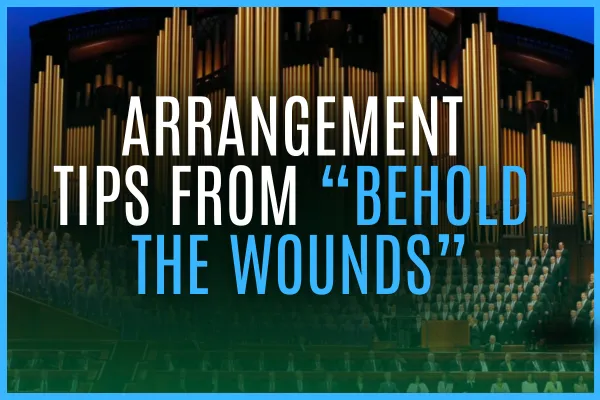
Arranging tips from "Behold the Wounds"
Yesterday, I led our Stake Choir in a presentation of David Naylor's beautiful piece, "Behold the Wounds in Jesus' Hands."
I was very proud of them.
They sang their hearts out and brought the spirit in abundance.
I have a few favorite moments in this piece, which I thought would be fun to share with you.
Today, I'd like to look at a moment in the 1st interlude.
The men have just finished singing their unison verse.
The women are about to sing the 2nd verse.
But to prepare for the ladies, the organ begins in a high register with no pedals, as you can see below.
Bars 22-23 highlight the I chord, the IV, and the V, with a little subtle motion between them.
Then, in bars 24-25, we get a really beautiful moment.
Firstly, as you can see below, these 2 bars contain basically the same music.
The difference is, bar 25 is an octave lower, and has the return of the organ pedal.
Repeating a bar of music like this is a wonderful tactic, borrowed from the composers of the Romantic era, like Tchaikovsky.
It's a situation where there's a beautiful bit of music, but the composer wants to re-emphasize the feeling, so they repeat the same bar.
Often, this repetition is displaced by an octave, like it is here. But not always.
Take a look, and have a listen below. Then I explain how this works.
(Click below to listen, it begins at the 1:26 mark)
Oooooo! Don't you just LOVE that warm juicy return of the organ pedal?
I sure do.
And what is it that gives these chords that warm fuzzy feeling?
First, notice that each downbeat in these 2 bars contains a IV chord that then resolves to the I chord in 1st inversion (I⁶).
Second, notice how beat 4 of the previous bar (in both cases) is a lone D, tied over the bar.
Third, take a look at the two notes in the right hand on each of these downbeats... the C-sharp with an A below it.
Those 2 notes make the magic.
The C-sharp spills down out of the held D, walks down to a B, and then to an A on beat 3.
As it does, the C-sharp is accompanied by a 3rd below, the A. And then that A steps down to G.
But that's not all.
The lowest sound (the base line) follows this stepping down pattern, but not in quarter notes. Instead, it takes twice as long for the step to happen.
The C-sharp and A in the right hand are what we call, non-chord-tones. They do NOT belong to the IV chord.
By emphasizing these non-chord-tones on the strongest beat of the bar, we get a rush of musical warm fuzzies before it resolves down on beat 2.
And it's just too good to NOT repeat.
And to keep this repetition fresh, all he had to do was pull it down an octave and have the pedals play again.
Easy-peasy.
But what a result!
Arrangement tactics like this are some of the things we're going to play with in the upcoming 14-Day Hymn Arrangement Challenge.
This is an all-new challenge I've been working on.
It has MANY more easy-to-use tools than the challenges we've had in the past.
And I've been working hard to make it so it will only take 20-30 minutes of effort each day to finish your arrangement by the end of the 14th day.
Of course, everyone works at a different pace.
But, the goal is to make what can seem really overwhelming (arranging a piece for ward choir and piano/organ), a much more bite-sized experience that helps you gain confidence quickly.
If this sounds like fun to you, click the link below to put your name on the 14-Day Hymn Arrangement Challenge Waiting List.
I'll have the full details available soon.
For now, click here and put down your name so you don't miss a thing.
https://latterdaymusiversity.kit.com/challenge-wait-list
Tomorrow, I'll share another tip from this wonderful arrangement.
But this one has more to do with... for lack of a better term... the orchestration of the accompaniment.
Stay tuned!
Doug "knitting testimonies into arrangements" Pew